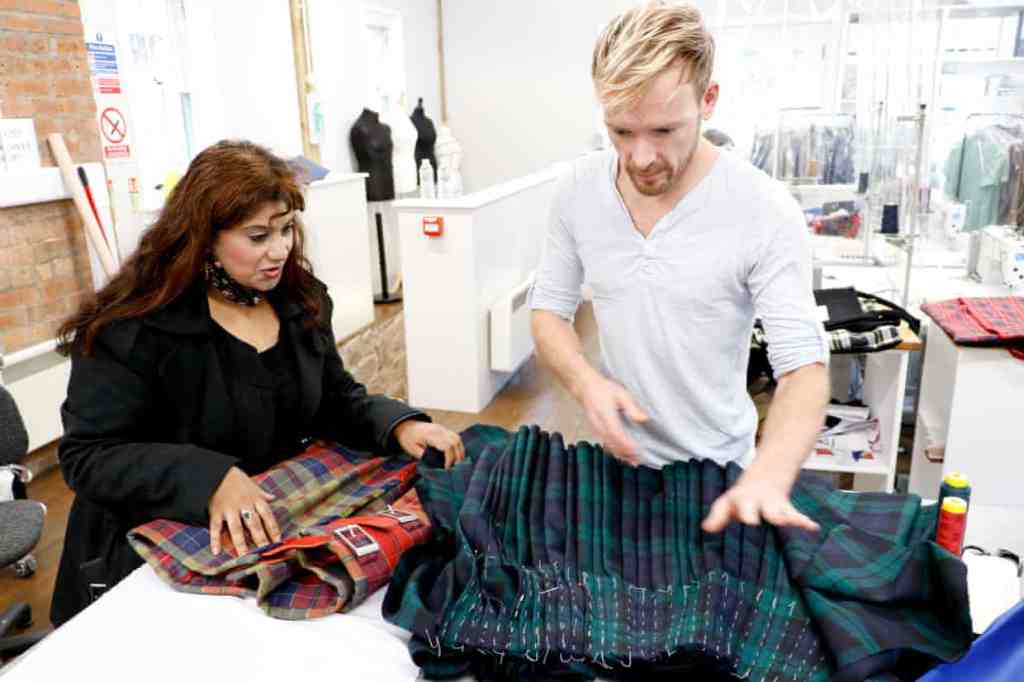
Photo: Iain Brown.
Kilt maker Graeme Bone. A new organization seeks to protect crafts that have fewer and fewer makers.
I don’t think of neon as an ancient craft, but I’m learning that lack of demand for it is endangering its future. It’s right up there with bagpipes.
At the Guardian, Alice Fisher reported recently on efforts to protect and pass along the skills of makers as varied as those who craft neon, kilts, bagpipes, and cricket bats.
“Nick Malyon was seduced by neon lighting at the end of the 1980s while traveling in America,” she writes. …
“ ‘I was introduced to a sign painter and a neon signmaker, and it seemed like an alternative lifestyle to the one I’d left behind. On my return to the UK, I was probably attempting to carry on some American dream by training, but I loved the weird alchemy of illuminating a piece of bent glass tubing – the change from nothing to something.’
“Malyon’s art [was on display in May], during London Craft Week (LCW), at the Vintage Supermarket, a Soho pop-up shop by Merchant & Found that specializes in 20th-century and industrial furniture. His work will represent one of the many endangered crafts on show this year.
“ ‘Over the centuries, crafts have ebbed and flowed; some die out but others grow to replace them,’ says Daniel Carpenter, executive director of Heritage Crafts, the charity that produces the annual red list of endangered skills. ‘But what we’re seeing now is something different – it’s like an extinction-level event.’
“Heritage Crafts’ red list includes gloomy news for British culture. Cricket ball manufacture is extinct in the UK, while cricket bats are on the endangered list alongside kilt- and bagpipe-making. Construction of currach boats and the sporran are also on the critical list.
“Carpenter says that competition from low-wage economies overseas is a key factor. … He says the situation is worse in the UK than in other European countries, but Heritage Crafts has just established a worldwide organization to monitor the situation. ‘There’s less support for training, and government-funded apprenticeships are very hard to access in the UK. They’re not set up for our sector – which is ironic, as apprenticeships were developed by craft guilds in medieval times.’
“Scottish kiltmaker Graeme Bone’s work will appear at LCW’s Craftworks. He retrained with a program offered by the Prince’s Foundation. Previously he was a steelworker: ‘Surprisingly, there are many cross-transferable skills from construction to pattern making – it’s all grids and measurements.’ …
“Rush weaver Felicity Irons, who is also exhibiting at LCW, received a British Empire medal in 2017 for saving the UK’s rush-cutting industry. She was focused on making seating when her rush supplier, Tom Arnold, died. Arnold’s brother was in his 70s and didn’t want to take over the trade, though it had been in his family since the 1500s. He gave Irons a two-hour training session before she took over.
“ ‘But I still get asked if this is my hobby. Though it’s better than it was when I set up – customers would be really rude to me about the prices and I had to stop myself from justifying it. I think it’s staggering that those plants growing in the river are being sent all around the world – our exports are really strong.’
“In June 2024, the UK will ratify Unesco’s Convention for the Safeguarding of the Intangible Cultural Heritage, which means the government commits to protect local crafts, social practices, festive events and rituals. A public register opened in January 2024 for British people to nominate local traditions for our national list. ‘It’s a step forward,’ said Carpenter, ‘but it’s largely symbolic.’ …
“While grants are hard to come by, some awards offer money prizes as well as recognition. The latest winner of the Loewe Foundation Craft prize, an international award, [was] announced in the same week as LCW. [Andrés Anza won.] …
“Abraham Thomas, curator of modern architecture, design and decorative arts at the Metropolitan Museum of Art in New York is one of the Loewe Prize judges this year. He feels some crafts people are adapting to the modern world.
“He says: ‘It’s interesting to note that several artists on this year’s shortlist have subverted traditional techniques and incorporated unexpected, recycled or industrial materials. They appear where other materials might be expected – all with the purpose of challenging craft traditions, legacies and expectations.’”’
“Carpenter also thinks craft is an innate human trait, and the loss of these skills goes beyond being a problem for our manufacturing sector or a waste of talent. ‘We’ve evolved as human beings to be makers,’ he said. ‘So for us to be living 24/7 in the digital world isn’t natural.’ …
“Malyon, though, has resigned himself to the death of his craft in the UK. ‘Since the advent of LED in the 2000s, neon trade worldwide has crashed. Brexit caused a price rise in our materials, all imported from Europe. I’ve never earned much and I work very long hours, but I really enjoy what I do.
“ ‘I just wanted to make neon signs, commercially, for whatever weird reason, so I feel I’ve been lucky. But as far as the UK craft is concerned, I don’t think anyone can stop it from dying.’ ” More at the Guardian, here.
I’m glad to read that someone is still doing work with rushes. A couple of our rush-bottom dining chairs were starting to need attention. Fortunately, the new owners of our house were happy to take them on.
